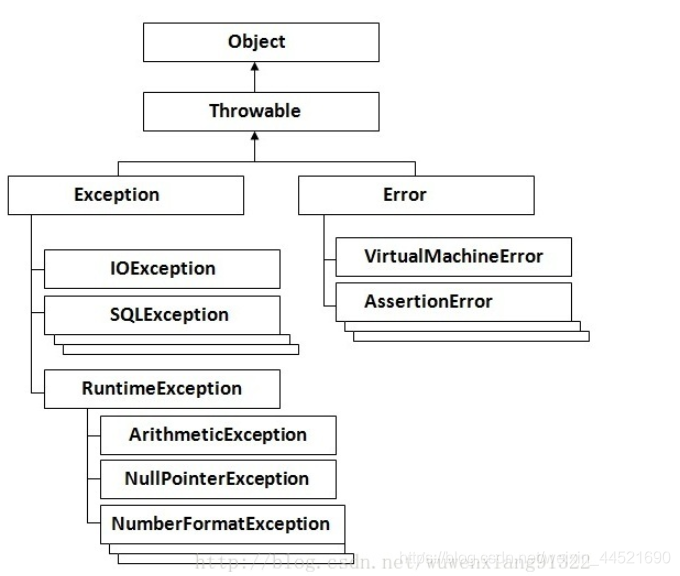Transactional属性详解 详解Spring中的Transactional属性
丶炜钦 人气:0一、Transactional
声明式事务管理建立在AOP之上的。其本质是对方法前后进行拦截,然后在目标方法开始之前创建或者加入一个事务,在执行完目标方法之后根据执行情况提交或者回滚事务。
简而言之,@Transactional注解在代码执行出错的时候能够进行事务的回滚。

二、使用说明

- 在启动类上添加@EnableTransactionManagement注解。
- 用于类上时,该类的所有 public 方法将都具有该类型的事务属性,同时,我们也可以在方法级别使用该标注来覆盖类级别的定义。
- 在项目中,@Transactional(rollbackFor=Exception.class),如果类加了这个注解,那么这个类里面的方法抛出异常,就会回滚,数据库里面的数据也会回滚。
- 在@Transactional注解中如果不配置rollbackFor属性,那么事物只会在遇到RuntimeException的时候才会回滚,加上rollbackFor=Exception.class,可以让事物在遇到非运行时异常时也回滚。
而至于什么是运行时异常(RuntimeException),什么是非运行时异常,可通过下图所示理解(图片截取网络)

三、注解失效问题
正常情况下,只要在方法上添加@Transactional注解就完事了,但是需要注意的是,虽然使用简单,但是如果不合理地使用注解,还是会存在注解失效的问题。
@Transactional 应用在非 public 修饰的方法上
事务拦截器在目标方法执行前后进行拦截,内部会调用方法来获取Transactional 注解的事务配置信息,调用前会检查目标方法的修饰符是否为 public,不是 public则不会获取@Transactional 的属性配置信息。
@Transactional 注解属性 rollbackFor 设置错误
rollbackFor 可以指定能够触发事务回滚的异常类型。Spring默认抛出了未检查unchecked异常(继承自 RuntimeException 的异常)或者 Error才回滚事务;其他异常不会触发回滚事务。如果在事务中抛出其他类型的异常,但却期望 Spring 能够回滚事务,就需要指定rollbackFor属性。
同一个类中方法调用,导致@Transactional失效
开发中避免不了会对同一个类里面的方法调用,比如有一个类Test,它的一个方法A,A再调用本类的方法B(不论方法B是用public还是private修饰),但方法A没有声明注解事务,而B方法有。则外部调用方法A之后,方法B的事务是不会起作用的。这也是经常犯错误的一个地方。
那为啥会出现这种情况?其实这还是由于使用Spring AOP代理造成的,因为只有当事务方法被当前类以外的代码调用时,才会由Spring生成的代理对象来管理。
异常被你的 catch“吃了”导致@Transactional失效
如果你手动的catch捕获这个异常并进行处理,事务管理器会认为当前事务应该正常commit,就会导致注解失效,如果非要捕获且不失效,就必须在代码块内throw new Exception抛出异常。
数据库引擎不支持事务
开启事务的前提就是需要数据库的支持,我们一般使用的Mysql引擎时支持事务的,所以一般不会出现这种问题。
开启多线程任务时,事务管理会受到影响
因为线程不属于spring托管,故线程不能够默认使用spring的事务,也不能获取spring注入的bean在被spring声明式事务管理的方法内开启多线程,多线程内的方法不被事务控制。
如下代码,线程内调用insert方法,spring不会把insert方法加入事务就算在insert方法上加入@Transactional注解,也不起作用。
@Service
public class ServiceA {
@Transactional
public void threadMethod(){
this.insert();
System.out.println("main insert is over");
for(int a=0 ;a<3;a++){
ThreadOperation threadOperation= new ThreadOperation();
Thread innerThread = new Thread(threadOperation);
innerThread.start();
}
}
public class ThreadOperation implements Runnable {
public ThreadOperation(){
}
@Override
public void run(){
insert();
System.out.println("thread insert is over");
}
}
public void insert(){
//do insert......
}
}
如果把上面insert方法提出到新的类中,加入事务注解,就能成功的把insert方法加入到事务管理当中
@Service
public class ServiceA {
@Autowired
private ServiceB serviceB;
@Transactional
public void threadMethod(){
this.insert();
System.out.println("main insert is over");
for(int a=0 ;a<3;a++){
ThreadOperation threadOperation= new ThreadOperation();
Thread innerThread = new Thread(threadOperation);
innerThread.start();
}
}
public class ThreadOperation implements Runnable {
public ThreadOperation(){
}
@Override
public void run(){
serviceB.insert();
System.out.println("thread insert is over");
}
}
public void insert(){
//do insert......
}
}
@Service
public class ServiceB {
@Transactional
public void insert(){
//do insert......
}
}
另外,使用多线程事务的情况下,进行回滚,比较麻烦。thread的run方法,有个特别之处,它不会抛出异常,但异常会导致线程终止运行。
最麻烦的是,在线程中抛出的异常即使在主线程中使用try…catch也无法截获这非常糟糕,我们必须要“感知”到异常的发生。比如某个线程在处理重要的事务,当thread异常终止,我必须要收到异常的报告,才能回滚事务。这时可以使用线程的UncaughtExceptionHandler进行异常处理,UncaughtExceptionHandler名字意味着处理未捕获的异常。更明确的说,它处理未捕获的运行时异常。
如下代码
线程出要使用
①处要抛出异常
②处要捕捉异常,并且要抛出RuntimeException
③处手动处理回滚逻辑
@Service
public class ServiceA {
@Autowired
private ServiceB serviceB;
@Transactional
public void threadMethod(){
this.insert();
System.out.println("main insert is over");
for(int a=0 ;a<3;a++){
ThreadOperation threadOperation= new ThreadOperation();
Thread innerThread = new Thread(threadOperation);
innerThread.setUncaughtExceptionHandler(new Thread.UncaughtExceptionHandler() {
public void uncaughtException(Thread t, Throwable e) {
try {
serviceB.delete();③
} catch (Exception e1) {
e1.printStackTrace();
}
}
});
innerThread.start();
}
}
public class ThreadOperation implements Runnable {
public ThreadOperation(){
}
@Override
public void run(){
try {
serviceB.insert();
}catch (Exception ex){ ②
System.out.println(" Exception in run ");
throw new RuntimeException();
}
System.out.println("thread insert is over");
}
}
public void insert(){
//do insert......
}
}
@Service
public class ServiceB {
@Transactional
public void insert() throws Exception{ ①
//do insert......
}
@Transactional
public void delete() throws Exception{
//do delete......
}
}
加载全部内容